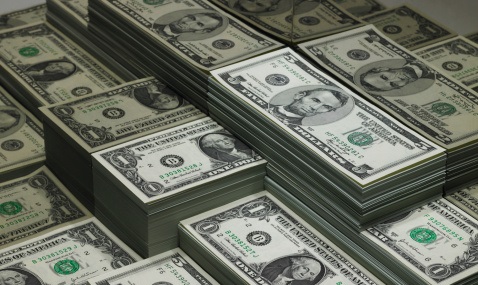US equity markets managed a decent recovery from lows during yesterday’s US trading hours, with the S&P 500 rebounding from lows around 4060 to close above 4100 (though still ended the session in the red) a level above which the E-mini S&P 500 future has manged to remain supported during overnight and early European trade, perhaps aided by support in the form of the 50DMA at close to 4080. Lower crude oil prices and a crash in crypto markets was the main factor cited as to why stocks struggled yesterday, and the former may be a problem for equities again today (crude is down another 1.0% – more on that below). But US stocks were surprisingly resilient in the aftermath of what market commentators and analysts have broadly called a hawkish FOMC minutes release; the minutes revealed that some within the FOMC are pushing to start talking about tapering the bank’s asset purchases (currently running at $120B per month). As inflation concerns grow, these calls are likely to grow louder and in various investor surveys, equity market participants have cited pre-mature tapering as the key market risks. European equities, meanwhile, are seeing some gains (Stoxx 600 +0.5%), with some market commentators citing a spate of recent upgrades to European equities as a positive (Credit Suisse were the latest to upgrade European equities to overweight).
In terms of government debt markets, US bond yields did not see too much of a reaction to the latest Fed minutes and 10-year yields are down about 1bps this morning, though continue to trade with a positive bias on the week to the north of the 1.65% mark (having start the week around 1.60%). European bond yields, meanwhile, are not seeing too much action this morning with Italian BTPs flat around 1.10% and Bunds not much changed just to the north of -0.1%, though yields are likely to remain supported in the Eurozone as expectations for any extension to the ECB’s accelerated pace of weekly PEPP purchases are priced out of markets (the bank has been sending signals that it is happy with the recent rise in yields amid a better economic backdrop, raising expectations the bank will reduce the pace of weekly QE purchases).
With regards to how commodities are performing this morning; crude oil prices continue to come under pressure, with WTI down another more than 1.0% on the day and now trading in the mid-$62.00s, meaning it has now pulled back more than 6.5% from the more than two-month highs set earlier on this week just under $67.00. According to Iranian President Rouhani, main agreement on the return of the US and Iran to the JCPOA nuclear deal has been reached and the US have agreed to lift all major sanctions. Consultations are now focused on how to monitor the implementation of the current understanding. Agreement paves the way for millions of barrels per day in Iranian crude oil production to return to the global market, hence the ongoing pressure being seen in crude oil prices; note that many analysts retain a bullish bias on oil in the medium-term, however, given 1) expectations that global markets will be able to soak up additional Iranian supply (aided by other OPEC+ members reducing their own output to make up for higher Iranian output) and 2) expectations for a surge in crude oil demand as the global pandemic is gradually brought under control, which is expected to happen eventually with the global rollout of vaccines.
Elsewhere, industrial metals prices flopped during Thursday’s Asia session and have been unable to recover in European hours, with Dalian iron ore future prices down 7% and major steel benchmark prices down by a similar margin as speculators took profit in wake of yesterday’s announcement by Chinese authorities that they will be stepping up oversight to curb excessive increases in price. Copper has somewhat bucked the trend this morning, however, with LME future prices trading flat around the $10K mark, aided by a slightly weaker US dollar and the ongoing threat of strike action in Chile’s major Escondida mine. In terms of precious metals, gold is down about $10 from yesterday’s closing levels and trading around $1870, but retains its broadly positive short-term bias amid the slightly softer US dollar, slightly lower bond yields and amid continued pessimism in crypto markets – while Bitcoin has bounced sharply from yesterday’s lows of just above $30K and has managed to reclaim the $40K handle (meaning a more than 33% bounce from lows!), the cryptocurrency still trades lower by more than 10% on the week.
Recent losses in the likes of bitcoin, an asset which is often suggested has “inflation hedge”/ “store-of-wealth” properties akin to gold, seems to have spurred some flows out of the digital asset and into gold ETFs. How long these flows might endure is difficult to forecast, but for the time being it seems that what is bad for bitcoin (and crypto more broadly) is good for gold. The recent sell-off in crypto markets has been triggered by Elon Musk’s decision for Tesla to stop accepting Bitcoin as a payment mechanism for its cars (damaging the narrative that crypto is becoming mainstream in big business and at financial institutions) and in wake of China’s decision to ban domestic firms from offering crypto-related services as the country continues to move towards issuing its own digital yuan (thus triggering fears of further regulation pushing crypto currency usage to the side-lines).
Turning to FX markets; the US dollar saw some decent gains in wake of yesterday’s “hawkish” FOMC minutes, with the DXY rallying from around 89.90 to momentarily reclaim the 90.20 level, but during the overnight Asia and morning European session, most of these gains have been gradually handed back, though the DXY is managing to hold onto the 90.00 handle for now. Still, it is the worst performing major G10 currency this morning, down just over 0.1% on the day and giving a broad but modest boost to its major G10 counterparts. AUD is the best performer in the G10, with AUDUSD having recently recovered from session lows in the 0.7730s to trade back above 0.7750 and eyeing a test of earlier session highs above the 50DMA and in the 0.7760s. A strong employment report for the month of April seems to be helping the Aussie shrug off losses in key metal prices (like iron ore); though the headline jobs number missed expectations with a surprise 30K drop in employment, this was mainly due to part-time job losses, and full-time jobs posted a more than 30K gain on the month. Meanwhile, the country’s unemployment rate unexpectedly dropped from 5.5% to 5.6%.
NZD, meanwhile, has failed to recover quite so much from earlier session lows around 0.7170 and currently trades close to 0.7180, with last night’s new and upbeat New Zealand government fiscal forecasts having not given the kiwi as much of a hand. On the day, NZD trades higher by about 0.2%, with similar gains versus the dollar being seen in JPY, CHF, CAD and EUR. Decent trade data might be helping out the yen a little, but otherwise, fundamental catalysts for these four have been light; USDJPY trades with a negative bias just under the 109.00 level, USDCHF is currently looking to break back under 0.9000, USDCAD is hovering just to the north of the 1.2100 level and EURUSD is currently attempting to reclaim 1.2200.
The Day Ahead
ECB President Christine Lagarde is supposed to be speaking from 1300BST, and is likely to reiterate the recent line that the ECB is comfortable with the recent rise in European government bond yields. Focus will then shift to US weekly jobless claims numbers out at 1330BST (the trend has been positive in recent weeks), which also coincides with the release of the US Philly Fed Manufacturing survey for the month of May, which should attract some attention given it is one of the earliest reads into US economic performance on the month. Canada New Home Sales number are also out at 1330BST and will be watched by the Loonie traders, whose focus will then turn to a comment from BoC Governor Macklem at 1600BST on the bank’s Financial System Review. Bond traders will watch how a $13B US 10-year TIPS auction goes at 1800BST and then one Fed speaker is scheduled for 2305BST. Market catalysts are otherwise likely to be fairly light, and it will be worth keeping an eye on cryptocurrency markets in case of any further turmoil.




